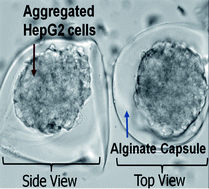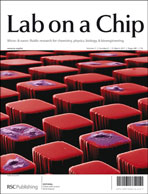Here, we present a novel and simple process of spheroid formation and in situ encapsulation of the formed spheroid without intervention. A hemispherical polydimethylsiloxane (PDMS) micromold was employed for the formation of uniform sized spheroids and two types of nano-porous membrane were used for the control of the crosslinking agent. We characterized the transport properties of the membrane, and the selection of alginate hydrogel as a function of gelation time, alginate concentration, and membrane type. Using the developed process and micromold, HepG2 cell spheroids were successfully formed and encapsulated in alginate without replating. This method allows spheroid encapsulation with minimal damage to the spheroid while maintaining high cell viability. We demonstrate the feasibility of this method in developing a bio-artificial liver (BAL) chip by evaluating viability and function of encapsulated HepG2 spheroids. This method may be applied to the encapsulation of several aggregating cell types, such as β-cells for islet formation and stem cells for embryonic body preservation, or as a model for tumor cell growth and proliferation in a 3D hydrogel environment.

You have access to this article
 Please wait while we load your content...
Something went wrong. Try again?
Please wait while we load your content...
Something went wrong. Try again?


 Please wait while we load your content...
Please wait while we load your content...